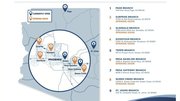News
Dove study contrasts debit markets in U.S., Canada
February 11, 2004
HOUSTON - The U.S. debit payments system saved cardholders more than $4.3 billion in fees last year when compared to the system utilized in Canada, according to a newly released white paper commissioned by the Pulse EFT Association.
Late last year, Pulse engaged Boston-based Dove Consulting to analyze and compare the debit system utilized in Canada with the U.S. debit payment system. Stan Paur, Pulse's president and chief executive, said the study was prompted by references made at conferences and by industry commentators citing the benefits of the Canadian debit model compared to the U.S.
Some of the key differences between the two markets:
- There is only one form of debit in Canada -- PIN-based -- which is supported by a single EFT network, Interac.
- Canada has only eight major national banks, which control 93 percent of banking assets. By contrast, the U.S. has more than 17,000 banks and credit unions; the eight largest banks control only 41 percent of banking assets.
- Canadian consumers pay a fee (typically C50 cents to 60 cents or U.S. 37 cents to 45 cents) to their financial institution for each electronic payment transaction, whether using a debit card to make a purchase or getting cash from an ATM. In the U.S., consumers generally pay nothing to make purchases or access cash from their financial institution's ATMs.
- Canadian consumers typically pay a fee each time they write a check, whereas many U.S. banks promote free checking. Per-check fees paid by Canadian consumers generally are higher than those they pay for PIN debit transactions.
- Canadian merchants pay no interchange fees for debit transactions, whereas U.S. financial institutions receive revenue from merchants for use of their databases and for guaranteeing payment for every transaction
Paur said that it is important not to dismiss arbitrarily calls for change in electronic payments. However, at the same time, he said it is essential to appreciate the impact of change on the users of the system.
While it is understandable why retailers would prefer a no interchange fee environment, Paur said, it is unclear how consumers would respond to or benefit from the shifting of costs.
After contrasting the two systems, the Dove white paper concludes that the Canadian model is unlikely to be embraced in this country anytime soon.
"It is highly improbable that the U.S. could ever transition to such a model," said Tony Hayes, managing director of Dove's Financial Services Practice and author of the report. "The ultimate challenge is to insure that competitive and efficient alternatives exist for retailers, the financial industry and, most of all, consumers."
An executive summary and full Dove report is available at the Pulse Web site.














